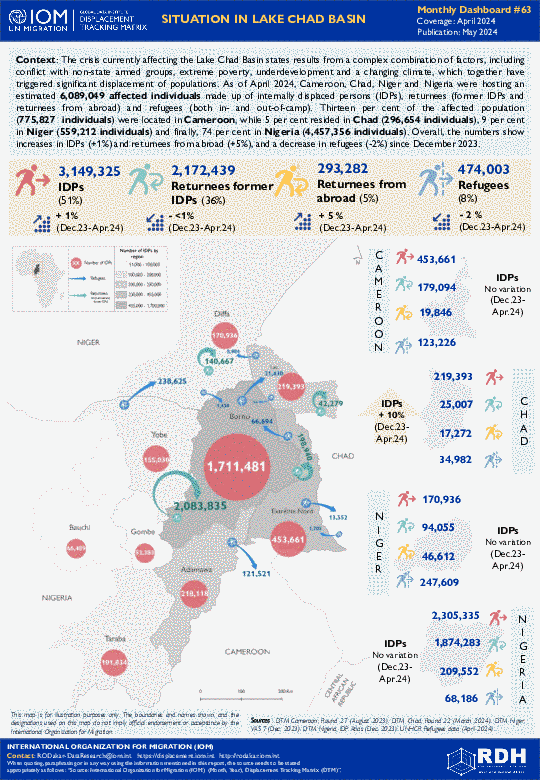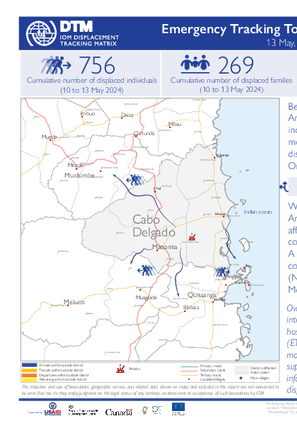-
Countries
-
Data and Analysis
-
Special Focus
-
Crisis Responses
The crisis currently affecting the Lake Chad Basin states results from a complex combination of factors, including conflict with non-state armed groups, extreme poverty, underdevelopment and a changing climate, which together have triggered significant displacement of populations. As of April 2024, Cameroon, Chad, Niger and Nigeria were hosting an estimated 6,089,049 affected individuals made up of internally displaced persons (IDPs), returnees (former IDPs and returnees from abroad) and refugees (both in- and out-of-camp). Thirteen per cent of the affected population (775,827 individuals) were located in Cameroon, while 5 per cent resided in Chad (296,654 individuals), 9 per cent in Niger (559,212 individuals) and finally, 74 per cent in Nigeria (4,457,356 individuals). Overall, the numbers show increases in IDPs (+1%) and returnees from abroad (+5%), and a decrease in refugees (-2%) since December 2023.
Contact
iomyemendtm@iom.int
Location
Yemen
Activity
- Flow Monitoring
Period Covered
Apr 01 2024 -Apr 30 2024
In April 2024, the IOM Yemen DTM reported 1,479 migrants entering Yemen, a 23 percent decrease from the total figure reported in the previous month (1,930 migrants). All migrants left from Bari region in Somalia (1,479) and arrived in Shabwah governorate in Yemen, which typically serves as a key entry point for migrants leaving Somalia. Moreover, migrants leaving from Djibouti rarely choose Shabwah due to the significant distance between the two locations.
Although all migrants arrived through Shabwah coastal area, the number of migrants entering through same area decreased by 18 per cent in April (1,479) compared to March 2024 (1,800). Among the total migrants recorded, 22 per cent were children, 15 per cent were women, and 63 per cent were men. According to data collected for April 2024, 74 per cent of migrants stated that conflict was the primary reason for them leaving their country of origin.
The DTM team identified 5,046 Yemeni returnees in April 2024, a 19 percent increase compared to the number of returnees in March (4,226 individuals). Additionally, the team also recorded total of 191 migrants that were deported from Oman back to Deifen Point in Shahan district of Al Maharah governorate, Yemen. All deported migrants from Oman were Ethiopian nationals.
The worsening humanitarian crisis in Yemen has compelled many migrants to make difficult decision to return to their home countries in the Horn of Africa, some have reportedly been deported by authorities. In April 2024, the DTM recorded a total of 819 migrants leaving Yemen either voluntarily or were deported by boat from Yemen. This group was composed of 91 per cent men, eight per cent women, and less than one per cent children.
Furthermore, in April 2024, the Djibouti DTM team reported a total of 631 migrants (93% men, 4% women, and 3% children) arrived in Djibouti from Yemen after undertaking a perilous journey back home. These figures underscore the significant challenges migrants in Yemen face and the desperate circumstances that have led them to risk dangerous sea voyages.
Population Groups
Migrants Present
Survey Methodology
Unit of Analysis Or Observation
Admin Area 2
Admin Area 4
Individual
Type of Survey or Assessment
Key Informant
Keywords
Geographical Scope Partial Coverage
Administrative boundaries with available data
The current dataset covers the following administrative boundaries
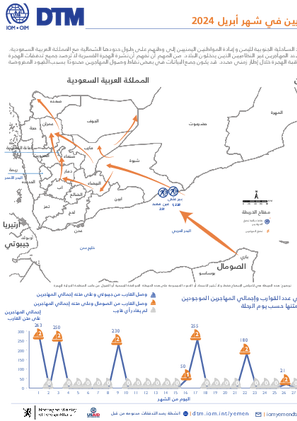
Contact
IOM DTM Yemen, iomyemendtm@iom.int
Language
Arabic
Location
Yemen
Period Covered
Apr 01 2024
Apr 30 2024
Activity
- Flow Monitoring
يراقب سجل مراقبة التدفق (FMR) الخاص بمصفوفة تتبع النزوح في اليمن (DTM) التابعة للمنظمة الدولية للهجرة، وصول المهاجرين على طول الحدود الساحلية الجنوبية لليمن وإعادة المواطنين اليمنيين إلى وطنهم على طول حدودها الشمالية مع المملكة العربية السعودية. يسجل القائمون بالتعداد في نقاط مراقبة التدفق وصول المهاجرين وعودة المواطنين اليمنيين لتحديد أنماط الهجرة المختلفة وتقديم تقديرات كمية لعدد المهاجرين غير النظاميين الذين يدخلون البلاد. من المهم أن نفهم أن نشرة الهجرة القسرية لا ترصد جميع تدفقات الهجرة في اليمن؛ وبدلا من ذلك، فإنه يوفر رؤى إرشادية حول اتجاهات الهجرة استنادا إلى عدد إجمالي غير معروف من المهاجرين الذين يصلون إلى نقاط مراقبة الهجرة خلال إطار زمني محدد. قد يكون جمع البيانات في بعض نقاط وصول المهاجرين محدودًا بسبب القيود المفروضة على الوصول.
في أغسطس 2023، بدأت حملة عسكرية مشتركة للحد من تدفق المهاجرين إلى اليمن، وخاصة أولئك الذين هم في طريقهم إلى المملكة العربية السعودية ودول الخليج الأخرى. استهدفت هذه العملية ساحل محافظة لحج، وهي نقطة دخول رئيسية لعدد كبير من المهاجرين (ما يصل إلى 15,714 مهاجرًا في مارس 2023). واحتجزت القوات العسكرية المهربين وطاردت قواربهم، مما أدى إلى انخفاض تدريجي في تدفق المهاجرين عبر هذا الساحل، والذي توقف تمامًا في نهاية المطاف خلال الأشهر الستة الماضية. كان هناك استثناء واحد في منتصف ديسمبر 2023 عندما أحضر قارب 110 مهاجرين إلى الشاطئ.
في أبريل 2024، أبلغت مصفوفة تتبع النزوح التابعة للمنظمة الدولية للهجرة في اليمن عن دخول 1,479 مهاجرًا إلى اليمن، وهو انخفاض بنسبة 23 بالمائة عن الرقم الإجمالي المُبلغ عنه في الشهر السابق (1,930 مهاجرًا). غادر جميع المهاجرين من منطقة باري في الصومال (1,479) ووصلوا إلى محافظة شبوة في اليمن، والتي عادة ما تكون بمثابة نقطة دخول رئيسية للمهاجرين الذين يغادرون الصومال. علاوة على ذلك، نادراً ما يختار المهاجرون المغادرون من جيبوتي شبوة بسبب المسافة الكبيرة بين الموقعين.
على الرغم من وصول جميع المهاجرين عبر منطقة شبوة الساحلية، إلا أن عدد المهاجرين الذين يدخلون عبر نفس المنطقة انخفض بنسبة 18 في المائة في أبريل (1,479) مقارنة بشهر مارس 2024 (1,800). ومن بين إجمالي المهاجرين المسجلين، كان 22 في المائة أطفال، و15 في المائة نساء، و63 في المائة رجال. ووفقاً للبيانات التي تم جمعها لشهر أبريل 2024، ذكر 74% من المهاجرين أن النزاع كان السبب الرئيسي وراء مغادرتهم بلدهم الأصلي.
حدد فريق مصفوفة تتبع النزوح 5,046 عائداً يمنياً في أبريل 2024، أي بزيادة قدرها 19 بالمائة مقارنة بعدد العائدين في مارس (4,226 فرداً). بالإضافة إلى ذلك، سجل الفريق أيضًا إجمالي 191 مهاجرًا تم ترحيلهم من عمان إلى نقطة ديفين في مديرية شحن بمحافظة المهرة باليمن. وكان جميع المهاجرين المرحلين من عمان مواطنين إثيوبيين.
أجبرت الأزمة الإنسانية المتفاقمة في اليمن العديد من المهاجرين على اتخاذ قرار صعب بالعودة إلى بلدانهم الأصلية في القرن الأفريقي، حيث أفادت التقارير أن السلطات قامت بترحيل بعضهم. في أبريل 2024، سجلت مصفوفة تتبع النزوح ما مجموعه 819 مهاجرًا غادروا اليمن إما طوعًا أو تم ترحيلهم بالقوارب من اليمن. وتتكون هذه المجموعة من 91 في المائة من الرجال، و8 في المائة من النساء، وأقل من 1 في المائة من الأطفال.
علاوة على ذلك، في أبريل 2024، أفاد فريق مصفوفة تتبع النزوح في جيبوتي أن ما مجموعه 631 مهاجرًا (93٪ رجال، 4٪ نساء، و3٪ أطفال) وصلوا إلى جيبوتي قادمين من اليمن بعد القيام برحلة محفوفة بالمخاطر للعودة إلى الوطن. وتؤكد هذه الأرقام التحديات الكبيرة التي يواجهها المهاجرون في اليمن والظروف اليائسة التي دفعتهم إلى المخاطرة برحلات بحرية خطيرة.
Between 10 to 12 May 2024, attacks, and fear of attacks by Non-state Armed Groups in Macomia triggered the cumulative displacement of 756 individuals/ 269 families. The current Movement Alert #111 reports on most recent attacks in Northen Cabo Delgado. For more information on displacements between February and April, please see {Emergency Tracking Online Dashboard}.
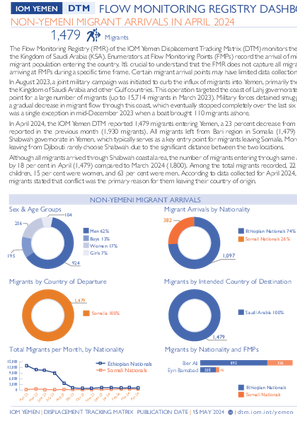
Contact
IOM DTM Yemen, iomyemendtm@iom.int
Language
English
Location
Yemen
Period Covered
Apr 01 2024
Apr 30 2024
Activity
- Flow Monitoring
The Flow Monitoring Registry (FMR) of the IOM Yemen Displacement Tracking Matrix (DTM) monitors the arrival of migrants along Yemen’s southern coastal border and the repatriation of Yemeni nationals along its northern border with the Kingdom of Saudi Arabia (KSA). Enumerators at Flow Monitoring Points (FMPs) record the arrival of migrants and the return of Yemeni nationals to identify various migration patterns and provide quantitative estimates of the irregular migrant population entering the country. It’s crucial to understand that the FMR does not capture all migration flows in Yemen; instead, it provides indicative insights into migration trends based on an unknown total number of migrants arriving at FMPs during a specific time frame. Certain migrant arrival points may have limited data collection due to access constraints.
In August 2023, a joint military campaign was initiated to curb the influx of migrants into Yemen, primarily those en route to the Kingdom of Saudi Arabia and other Gulf countries. This operation targeted the coast of Lahj governorate, a major entry point for a large number of migrants (up to 15,714 migrants in March 2023). Military forces detained smugglers and chased their boats, leading to a gradual decrease in migrant flow through this coast, which eventually stopped completely over the last six months. There was a single exception in mid-December 2023 when a boat brought 110 migrants ashore.
In April 2024, the IOM Yemen DTM reported 1,479 migrants entering Yemen, a 23 percent decrease from the total figure reported in the previous month (1,930 migrants). All migrants left from Bari region in Somalia (1,479) and arrived in Shabwah governorate in Yemen, which typically serves as a key entry point for migrants leaving Somalia. Moreover, migrants leaving from Djibouti rarely choose Shabwah due to the significant distance between the two locations.
Although all migrants arrived through Shabwah coastal area, the number of migrants entering through same area decreased by 18 per cent in April (1,479) compared to March 2024 (1,800). Among the total migrants recorded, 22 per cent were children, 15 per cent were women, and 63 per cent were men. According to data collected for April 2024, 74 per cent of migrants stated that conflict was the primary reason for them leaving their country of origin.
The DTM team identified 5,046 Yemeni returnees in April 2024, a 19 percent increase compared to the number of returnees in March (4,226 individuals). Additionally, the team also recorded total of 191 migrants that were deported from Oman back to Deifen Point in Shahan district of Al Maharah governorate, Yemen. All deported migrants from Oman were Ethiopian nationals.
The worsening humanitarian crisis in Yemen has compelled many migrants to make difficult decision to return to their home countries in the Horn of Africa, some have reportedly been deported by authorities. In April 2024, the DTM recorded a total of 819 migrants leaving Yemen either voluntarily or were deported by boat from Yemen. This group was composed of 91 per cent men, eight per cent women, and less than one per cent children.
Furthermore, in April 2024, the Djibouti DTM team reported a total of 631 migrants (93% men, 4% women, and 3% children) arrived in Djibouti from Yemen after undertaking a perilous journey back home. These figures underscore the significant challenges migrants in Yemen face and the desperate circumstances that have led them to risk dangerous sea voyages.
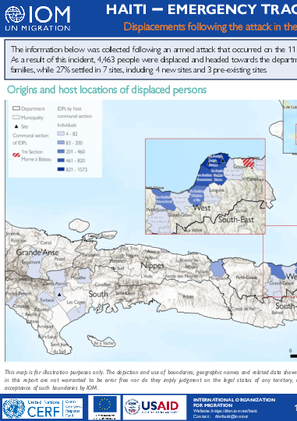
Contact
dtmhaiti@iom.int
Language
English
Location
Haiti
Period Covered
May 11 2024
May 12 2024
Activity
- Mobility Tracking
- Event Tracking
The information below was collected following an armed attack that occurred on the 11 of May 2024 in the municipality of Gressier, specifically in the 1st section of Morne à Bateau. As a result of this incident, 4,463 people were displaced and headed towards the departments of Ouest (92%), Nippes (4%), and Sud (3%). Among them, 73% found refuge with host families, while 27% settled in 7 sites, including 4 new sites and 3 pre-existing sites.

Contact
DTM DRC — iomdrcdtm@iom.int
Language
French
Location
Democratic Republic of the Congo
Period Covered
Apr 25 2024
May 06 2024
Activity
- Mobility Tracking
- Event Tracking
L’évaluation rapide de l’OIM (Emergency Event Tracking, EET) est un outil mis en place dans le but de collecter des informations sur les mouvements importants et soudains des populations. Ces informations sont collectées à la suite de visites terrain et/ou d’entr etiens téléphoniques avec les informateurs clés des sites de déplacement ou des communautés d’accueil. Les informations sont ensuite recueillies dans les outils ERM. Ce rapport synthétique présente les résultats des évaluations réalisées du 25 avril – 6 mai 2024 à travers des évaluations menées sur terrain avec les informateurs clés. La province du Tanganyika est confrontée à un nombre de situations interconnectées qui sont liées à la mobilité humaine. Le changement climatique, dont les effets sont déjà visibles dans la région, a entraîné une montée des eaux des rivières et du lac Tanganyika, ainsi qu'une augmentation des phénomènes météorologiques extrêmes tels que les canicules et les inondations. Les inondations et les pluies torrentielles, phénomènes récurrents au Tanganyika depuis février 2024, ont particulièrement affecté les établissements côtiers du lac Tanganyika. Les inondations, l'érosion et les glissements de terrain ont causé la destruction d'habitations et d'infrastructures et ont entraîné le déplacement des populations locales, en particulier à : Rugo, Kamenge, Kimomo, Kabubili et toute la rive du lac le long de l'axe Kabimba dans le groupement Kasanga Mtoa, Tumbwe Chefferie. Des dommages/destructions de plus d'un millier d'habitations ainsi que des terres agricoles, des récoltes, d'autres biens mobiliers et des écoles ont été signalés. Plus de 1 800 ménages ont trouvé refuge auprès de familles d'accueil dans des villages et localités plus sûrs, ainsi que dans le site de déplacement de Rugo (sous la coordination de l'OIM).
May 13 2024
Print
The operation aims to present migration dynamics in Kyrgyzstan, drawing upon data from 2022 and 2023 from national and international datasets on migratory movements. It covers recent major global and regional developments which will continue to have an impact on internal and international migration in the country. The operation was done through desk research, literature review and statistical analysis of relevant primary and secondary sources. The MTM team collected and processed statistical data, including all those relevant for the analysis of mobility outflows and inflows to the country in the last two years.
Countries in this response
- Active DTM operation
- Past DTM operation
Contact
DTM Yemen, iomyemendtm@iom.int
Location
Yemen
Activity
- Mobility Tracking
- Event Tracking
Period Covered
May 05 2024 -May 11 2024
From 1 January to 11 May 2024, IOM Yemen DTM tracked 1,233 households (HH) (7,398 Individuals) who experienced displacement at least once.
Between 5 and 11 May 2024, IOM Yemen DTM tracked 47 households (282 individuals) displaced at least once. The majority of people moved into/within the following governorates and districts:
- Ma’rib (28 HHs) – Ma’rib City (14 HHs), Ma’rib (13 HHs), Harib (1 HH) districts. Most displacements in the governorate originated from Ta’iz and Al Hodeidah.
- Al Hodeidah (16 HHs) – Al Khukhah (13 HHs), Hays (3 HHs) districts. Most displacements in the governorate were internal.
- Ad Dali (2 HHs) – Qatabah (2 HHs) district. All displacements in the governorate were internal.
The majority of people moved from the following governorates and districts:
- Al Hodeidah (18 HH) – At Tuhayta (8 HHs), Bayt Al Faqih (6 HHs), Bajil (2 HHs) districts.
- Ta’iz (13 HH) – Maqbanah (4 HHs), Ash Shamayatayn (3 HHs), Hayfan (3 HHs) districts.
- Hajjah (4 HH) – Hajjah City (2 HHs), Harad (1 HH), Al Jamimah (1 HH) districts.
Population Groups
IDPs
Returnee (Previously Internally Displaced)
Survey Methodology
Unit of Analysis Or Observation
Admin Area 2
Type of Survey or Assessment
Household
Keywords
Geographical Scope Partial Coverage
Administrative boundaries with available data
The current dataset covers the following administrative boundaries
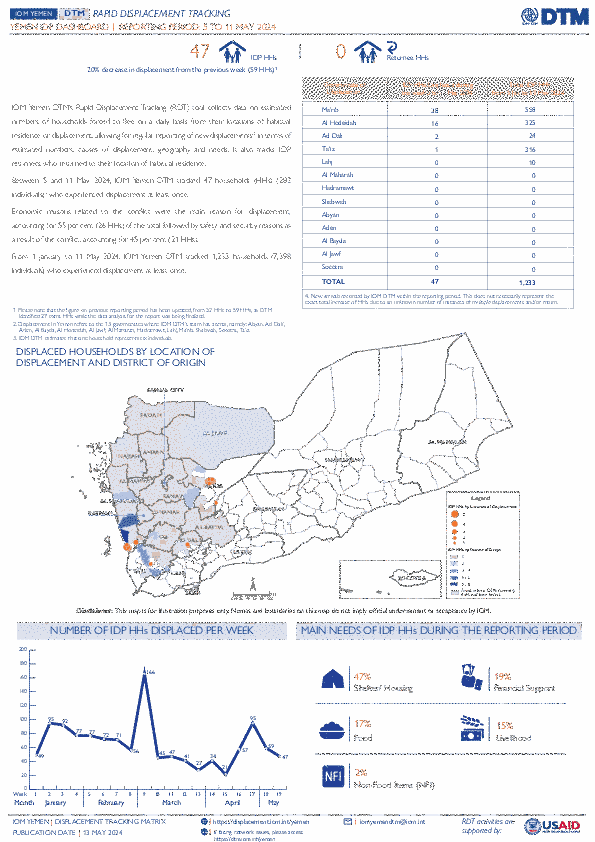
Contact
DTM Yemen, iomyemendtm@iom.int
Language
English
Location
Yemen
Period Covered
May 05 2024
May 11 2024
Activity
- Mobility Tracking
- Event Tracking
IOM Yemen DTM’s Rapid Displacement Tracking (RDT) tool collects data on estimated numbers of households forced to flee on a daily basis from their locations of origin or displacement, allowing for regular reporting of new displacements in terms of estimated numbers, geography, and needs. It also tracks returnees who returned to their location of origin.
From 1 January to 11 May 2024, IOM Yemen DTM tracked 1,233 households (HH) (7,398 Individuals) who experienced displacement at least once.
Between 5 and 11 May 2024, IOM Yemen DTM tracked 47 households (282 individuals) displaced at least once. The majority of people moved into/within the following governorates and districts:
- Ma’rib (28 HHs) – Ma’rib City (14 HHs), Ma’rib (13 HHs), Harib (1 HH) districts. Most displacements in the governorate originated from Ta’iz and Al Hodeidah.
- Al Hodeidah (16 HHs) – Al Khukhah (13 HHs), Hays (3 HHs) districts. Most displacements in the governorate were internal.
- Ad Dali (2 HHs) – Qatabah (2 HHs) district. All displacements in the governorate were internal.
The majority of people moved from the following governorates and districts:
- Al Hodeidah (18 HH) – At Tuhayta (8 HHs), Bayt Al Faqih (6 HHs), Bajil (2 HHs) districts.
- Ta’iz (13 HH) – Maqbanah (4 HHs), Ash Shamayatayn (3 HHs), Hayfan (3 HHs) districts.
- Hajjah (4 HH) – Hajjah City (2 HHs), Harad (1 HH), Al Jamimah (1 HH) districts.
IOM identified 27 additional households displaced in the previous reporting period, which covered 28 April - 04 May 2024, in the governorates of Al Hodeidah (15 HHs), Ma’rib (11 HH), and Ta’iz (1 HH). These figures have been added to the cumulative displacement total recorded since the beginning of the year.
